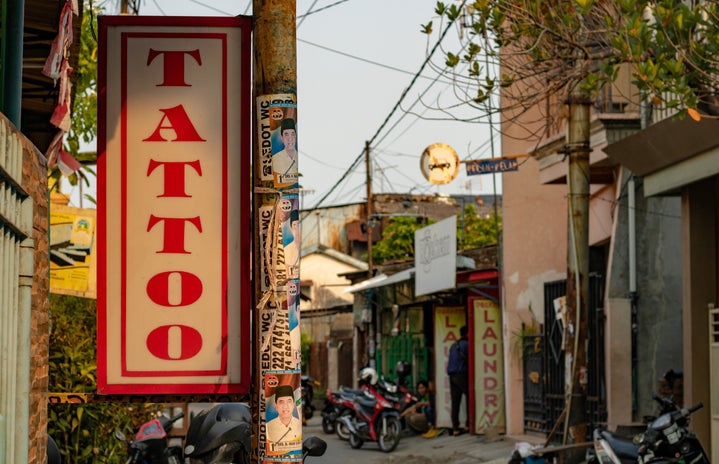Tattoos are a form of art, a body modification, a way to express oneself. Without a doubt, though, tattoos are also a big responsibility. They have the opportunity to be beautiful and a much-needed change—but if not properly taken care of, tattoos can improperly heal, scab, or even get infected. Before diving in head-first—despite how tempting it is—get a few hours of research under your belt. You don’t need to know the whole history of tattoos, but make sure you’re certain about where you want the tattoo, what design you want, and what artist you’ll trust. Most importantly, make sure you’re familiar with the after-care process.
Research Locations
Start off by doing research on where you’ll be getting your tattoo. Not only what area on your body you want the tattoo, but also what shop you want it done at and by who.
When deciding what area of your body you want tattooed, you need to contemplate your pain tolerance and just how badly you want said tattoo in said area.
I’ve had four tattoos done in two years: two on my left arm, one on my right, and one on my left ankle. The areas tattooed were all chosen based on how I pictured they would look. My pain tolerance is on a higher scale so placement of the tattoo is not a factor I contemplated too much. I have yet to get tattoos in more painful areas like the spine and rib area (although I am planning to get some in those areas). Out of the four I have, the one that hurt the most would probably be my very first one— on my right arm, about an inch above where my palm begins.
If you tend to struggle handling pain, then consider getting smaller tattoos on areas that won’t hurt as much as the back of your arm, your calf, or your forearm. Don’t plan for a face, hand, inner thigh, or throat tattoo when you can’t handle higher levels of pain. While tattoos are worth it after the pain, tattoo artists would prefer you don’t faint on the table.
If you’re passionate about a tattoo on a more painful area like the ones I listed, numbing cream might come to mind. If you’re debating whether to use it or not, contact the tattoo artist you’re working with. Most tattoo artists actually don’t like their clients using numbing cream. Numbing agents like sprays or creams could end up causing swelling and discoloration, ultimately impacting the tattoo in the long run. Not to mention some agents may include chemicals in them that could cause an allergic reaction. Tattoos are already a big body modification, so adding risk factors to it like unknown chemicals may make for a bad tat session.
If you feel like you won’t be able to handle the pain, yet desperately want the tattoo of your dreams, speak with your tattoo artist. In the end, they will most likely always be happy to help you. If they don’t, there are plenty of tattoo artists around. Just as you should be flexible with your artist, artists will be flexible with you.
The Artist and the art
It’s tempting to walk into the very first tattoo parlor you see, but getting to know the shop and its artists is an important step that will save you time, stress, and most importantly: money. If you get tattooed in the moment and end up hating the style, you might end up wasting money covering the tattoo up or getting laser removal. That’s why it’s important to get to know the artist tattooing you, as well as the shop’s policies.
Some artists don’t like tattooing ideas you find online. Some tattoo artists only like creating and tattooing their own designs on people. Of course, this isn’t everyone. In my case, all the tattoo artists I worked with were okay with the ideas I brought to them.
You always need to reach out to the artists and ask them what their preferences are, as well as what days they’re available. Not all artists are the same. Tattoo artists will appreciate your attempts at communication. In the end, both of you benefit from the mutual conversation. The artist gets to do what they love (and get paid) and you get a sick tat.
Most—if not all—tattoo artists have an Instagram account or some form of social media account. Take a look at the tattoos they’ve posted to see if their style and work fits your tastes.
Some tattoo parlors charge a minimum amount for services. These services may account for the table, the design, the stencil and the supplies needed for it, and so on. This is another reason why research is so important. If you’re hoping to not spend too much money on your very first tattoo, research is important. Some tattoo parlors may charge a different minimum than others; even artists within a store might charge different minimums than others. Different artists may use different tools and machines that may affect how much they charge.
Lost Lake Tattoo and Piercings Shop—a parlor in Miami, FL I’m committed to—has a handful of tattoo artists that all charge different minimums. One charges a minimum of $50, while another charges as much as $100. This, of course, is not that big of a deal if you’re getting a huge tattoo that will cost more than $100. But it is a deal-breaker if you’re only getting a small tattoo. If you’re not willing to pay $50 for a small tattoo, try looking for other places that may charge less. Remember, though: tattoo artists, like barbers, appreciate dedication and commitment.
It’s also important to keep in mind that the size and placement of your tattoo may also affect the price of it. In total, I have spent almost $500 on the four tattoos I have. My most recent tattoo cost me $300 due to it being bigger than five inches in height and extremely detailed. Another tattoo I have costed me $120—it’s smaller than my most recent one, but still very detailed.
Before and after care process
Everyone is aware that tattoos have an aftercare process, but many don’t realize there is also a pre-tattoo process you should follow.
Before getting on the table, make sure you’ve drunk enough water and eaten. Staying properly hydrated makes tattoos less painful, prevents excessive bleeding and makes the overall tattooing process go by much faster. Eating before a tattoo keeps you from fainting—something very important. Keep your skin hydrated and well taken care of. Practicing proper skincare will form good habits for future tattoos and, overall, make your tattoos look healthier and more appealing.
Once you hop off the table with your new tattoo, the first thing you should do is listen to your tattoo artist. Even if you’ve got tattoos done before, you should still hear the artist out. Certain wrappings they use may change the aftercare process. For example, some wrappings should only be kept on for two hours, while others should be kept on for up to 12 hours. Wrappings that are only worn for two hours should be taken off once the two-hour mark hits; the tattoo should be washed, gently moisturized, and then moisturized once more before going to bed. When it comes to those wrappings, wait 24 hours to shower. With wrappings that are worn for half a day, you can shower as soon as two hours after the tattoo.
Make sure to not slather too much moisturizer on your new tattoo, and make sure the lotion you use is scent or fragrance-free. Many artists have shared that people are often more likely to over-moisturize their new tattoos than anything else. Over-moisturizing your new tattoo prevents it from properly healing, which could affect how your tattoo looks once it is healed.
If you’re unsure if you’re over-moisturizing or not, moisturize it like you normally would, and then dab at the area with a paper towel. Moisturize the area once to twice a day, and rely on the paper towel if you slap on too much lotion.
If you want to keep your tattoo healthy, try not to expose it to direct sunlight and sweat for at least a week. Tattoos, depending on the size and placement, take around three to four weeks to fully heal. The area will feel tender and sore for the first week— regular pain meds will help with that. Once the tattoo is fully healed, you can moisturize and add sunscreen as much as you like. Doing this will keep the tattoo looking as new as when you first got it.
—
Getting a tattoo is more than worth it once you see it on your skin. To ensure a smooth and comfortable journey, make sure to communicate with your tattoo artist and to know your own limits and boundaries.
Regardless of if this is your first tattoo or one of many, knowing how to care for it will help it heal to its full potential and become a beautiful addition to your body, as well as a good conversation starter.


